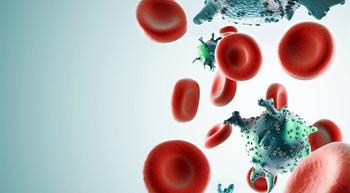
Clinical Trials on Smoldering Myeloma May Open Doors to More Precision Medicine
In an interview with CURE®, Dr. Irene M. Ghobrial discussed smoldering myeloma, a precursor condition that may progress to multiple myeloma, how to proceed if diagnosed with the condition and the available opportunities to participate in clinical trials to learn more.
Diagnosing smoldering myeloma with a blood test is the first important step to potentially preventing the progression to multiple myeloma, and a major focus has been placed to conduct clinical trials to learn more about this area, according to Dr. Irene M. Ghobrial.
Ghobrial, the director of the Clinical Investigator Research Program and Lavine Family Chair for Preventive Cancer Therapies at Dana-Farber Cancer Institute and professor of medicine at Harvard Medical School, recently discussed preventing the progression of smoldering myeloma during CURE®’s Educated Patient® Multiple Myeloma Summit.
In an interview with CURE®, Ghobrial defined multiple myeloma, what patients should do after their diagnosis, how to potentially prevention progression of the condition and the importance to participate in clinical trials.
CURE®: Can you go into detail what exactly is smoldering multiple myeloma?
Ghobrial: Smoldering multiple myeloma is a heterogeneous group of patients. Some of them look more like (monoclonal gammopathy of undetermined significant, or MGUS), and they may never progress or they progress very, very slowly. And some may look more like myeloma, and they progress very fast. And for us to tease apart this, this is the hardest thing because you're given this diagnosis of smoldering (myeloma), yet you don't know in which group you are in. And we need better risk stratification to tell us who truly will progress in their lifetime, and what to do about it.
And if I personally know I will likely progress to end-organ damage, meaning fractures of my bones, anemia, lytic lesions and renal failure in a couple of years, I might start considering, yes, I want early therapy to prevent progression. But if my chances of progression are only 5%, and I would progress in 10, 15 years from now, then I may want to opt for watching carefully and waiting for the new therapies to come, for a better precision medicine to come and not jump into treatment right now. And I think this is where we need to improve our precision. We need to be able to tell a patient in a more precise way, what is your true risk of progression so that they can have a better decision-making in that part?
In your presentation, you mentioned how every cancer starts with a precursor condition. Is there anything that makes smoldering multiple myeloma different than other precursor conditions?
Well, the one interesting thing is that we can diagnose it. So if you think about colon cancer, breast cancer, we're always trying to do cancer screening, we try to do colonoscopy, mammography, because the earlier the detection, the better, of course, the prognosis. If I can detect an early breast cancer lesion, I would be happy to get it out early and hopefully never develop breast cancer metastases. Yet in myeloma, all it needs is a blood test.
And you think, why aren't we doing that? Why are we not screening for myeloma? And this is why we have this
The other thing that's important is, we know that every single patient with myeloma, when they come in today and they have a bone lesion or anemia, and they're diagnosed with myeloma, they likely had a precursor condition, they likely went through MGUS and smoldering myeloma, but they didn't know about it because they were never diagnosed early with it.
Although this specific precursor condition differs from others, can smoldering multiple myeloma differ from patient to patient?
I think that every cancer is unique in a way. And that's why we actually think that therapy should be unique for every patient. We should not be lumping everyone the same way. In fact, the cancer cells themselves, by the time people have multiple myeloma, there is five different subclones within one patient. So within each patient, they have five different types of cancer cells. Some may have translocations, some may have acquired this specific mutation, these may respond differently than others. And that's why when we do next-generation sequencing, which I think we should be able, in the next few years, to provide it to everyone, we can have that precision to actually treat patients in a different way rather than treating every myeloma the same way or every smoldering myeloma the same way. We need to be not only saying, are you at high risk or not for smoldering myeloma, are you going to progress or not, but what is your biology? What is your own cancer cells telling us? Is it a p53 mutation? Is it an 11;14 translocation, and by knowing that, we can have a better precision therapy for those patients.
The other thing that we can add is the immune microenvironment. We know that the cancer cells don’t live alone, they live within that host, the immune microenvironment. And now we're also teasing that apart. To truly get that idea of early therapy means you can also develop immunotherapy to prevent progression. You don't even have to use the conventional treatment we have.
Once a patient is diagnosed with smoldering multiple myeloma, how should they proceed?
Well, the first thing, we know that smoldering multiple myeloma is diagnosed when they have 10% plasma cells. And the first thing that I think is important is a patient should say, I need to go see someone who really knows what multiple myeloma does, how do I treat this? A regular oncologist knows breast cancer, lung cancer and so many other things, but they don't truly know multiple myeloma, let alone smoldering myeloma, and what to do with it. So I think it's important to get a second opinion. We're happy to see you anytime. We’re doing virtual visits. You don't have to come all the way to Boston or to any other specialist to see us.
Then the second thing is knowing your own disease, being an advocate for yourself. And I think knowing not only your percentage of plasma cells, your M65, what is your risk factor, but also your own biology. Can I be part of a research study? Can I be really contributing into understanding better my own disease and making the decision for my own therapy or no therapy, and making that active participation in the decision making with your own doctor.
Your presentation was titled, “Prevention of Progression in Multiple Myeloma.” What are some of the ways that patients can actually prevent it?
So the first thing that we know is trying to know where they are in the spectrum? Are they in the MGUS stage? Are they in the smoldering stage? And again, it's just a spectrum, so some people may be right at that edge between MGUS and smoldering. It's almost the same disease, even if you have 10% plasma cells, but you're very low risk, you're still more of an MGUS like, or are you in the very high risk, you're almost myeloma, let's think of therapy. So I think knowing their own spectrum of the disease, knowing their own risk stratification, also knowing their own biology.
If we can do next-generation sequencing, knowing their cytogenetics and being empowered with their own data, then the next thing would be, do I need treatment or not? And is it an active clinical trial, which I would highly encourage participation on them, because I don't think we should change the standard of care yet. There are also trials that we're doing right now for the low risk patients. So if you're a high risk MGUS, low-risk smoldering, we're not talking about active therapy, we're talking about exercise and fitness, intermittent fasting, metformin studies, other things that are changing your own personal habits and changing your own fitness and exercise to help prevent progression. And we will get to know about those in years and years to come, but they may be some healthy habits that can help you in the early prevention.
If you are really in the late stages, I think these usually may not work that well. We need active therapy. And here we're trying to bring immunotherapy rather than conventional treatment to our patients.
Why is it so important to have so many of these ongoing studies? And why is it also important for patients to participate?
I think it's wonderful that we have so many options, because options equal that you can choose. And I think, again, interception or prevention of progression equals that you have also precision in it. Not every patient should go on the same trial. Some patients who have very high risk cytogenetics P53 mutation or 17p deletion, I would probably err on the side of more aggressive therapy or immunotherapy. Someone who has an 11;14 translocation, I may say, well, venetoclax (Venclexta and Venclyxto) would be a wonderful drug for you because you have the 11;14 translocation.
So, the more trials we have, the more options we have to actually pick and choose the right option for the patient. And at the end of the day, we cannot change standard of care unless we do clinical trials, unless we have something that shows a true benefit for patients over the standard of care, which is observation, or if you want to count the lenalidomide treatment that we have right now.
With all of these ongoing studies, we'll eventually get all of those available data. Where do you see this area going in the next few years with the release of those results?
I mean, I hope we have something approved. The low-hanging fruit is something approved for smoldering myeloma, that we do not wait for people — you know, the notion that someone has to wait until they have lesions in their bones or anemia, renal failure does not make sense. You don't have that in any other cancer, and you should never have that in myeloma. However, we have to be careful not to overtreat and not to cause toxicity. And I hope in the next few years, we can get that balance, we can truly treat early without the toxicity and the too much side effects that we have in some of the therapies.
We have also an amazing opportunity to truly develop precision medicine. We have an opportunity not to repeat what we've done in myeloma, which was wonderful, but it took us 15 years to get to three drugs and four drugs and more precision. Let's not repeat the same cycle for smoldering myeloma.
And I truly think that curative intent, if we really want to cure patients, treat them early. And we may end up knowing that answer once we actually finish the trials. And wouldn't it be amazing if we can truly say, I have cured the patient, or someone can say, I am cured. That's a word that we would love to see, that they're not on therapy, they don't have the disease and they're living a normal life. They can enjoy their life and not have to have the dread of, you know, constantly being on therapy, constantly thinking of their survival with multiple myeloma.
Is there anything else you’d like to tell patients that would be helpful?
I think being an active participant in any clinical trial, some of those trials are not even therapy. They’re just tissue banking, getting to know your data and you giving part of your cells, part of your blood sample for us to understand the research better. For example, the PROMISE study is part of that early screening to understand who truly has MGUS. We have
And of course, if you are high risk, if you need therapy, think about what are your best options, talk to several physicians. It's perfectly fine to get a second opinion. It's perfectly fine to be empowered with your own data before you start any active therapy. And again, it's really the discussion between the physician and the patient to come up with the best treatment option for every patient. And I think that's the art of medicine that we have in multiple myeloma.
For more news on cancer updates, research and education, don’t forget to




